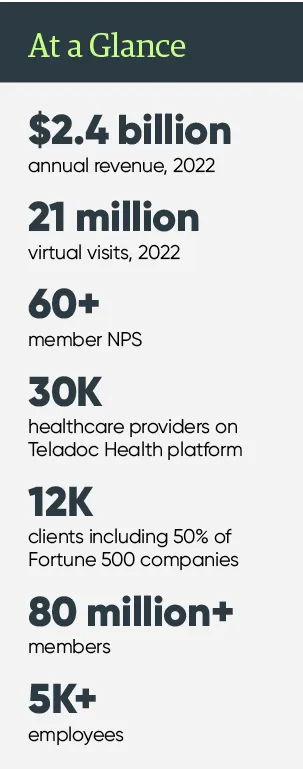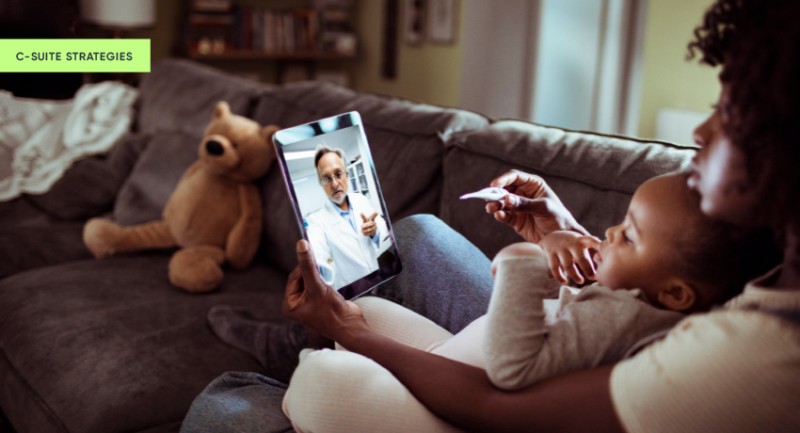It’s no surprise the telehealth services sector saw explosive growth when the pandemic forced medical care to be delivered online. What no one anticipated was how readily consumers would embrace digital care even after COVID-19 safety protocols lifted.
Though telehealth usage has dropped since its April 2020 peak, it’s still 38 times higher than pre-pandemic levels, according to McKinsey.

The Customer Strategist Journal sat down with a pioneer in this space, Teladoc Health. In a wide-ranging interview, Heather Underhill, SVP, client experience and operations, shared insights about elevating the experience for consumers as well as for employers and others who make the service available to end users.
Teladoc Health’s Net Promoter Score of 60 for consumers accessing chronic care or mental health services is impressive, given that any score above 50 is considered excellent. Teladoc Health’s Primary360, its primary care offering, earned an NPS of 70, regarded as world class.
Customer Strategist: Who is Teladoc Health and who are your customers?
Heather Underhill: Teladoc Health is the world’s largest virtual care organization. It’s been around more than 20 years, five years longer than the iPhone has been in people’s pockets. I just love that stat because it showcases how long we’ve focused on the opportunities that exist in helping our clients drive value with their members. One in four Americans has access to Teladoc Health through an employer, health plan, or hospital partnership.
CS: What is your philosophy and strategy around customer experience?
HU: Teladoc Health is a B2B2C organization and when we think about positive customer experiences, it’s really two sides of the same coin: the “consumers,” who are the members/patients and the “clients,” who are employers, hospitals, health plans, resellers, and brokers who contract with us to provide healthcare services to their employees, patients, and members.
CS: What are the building blocks of great CX for you?
HU: Journey mapping, feedback collection, gaining organizational alignment around those experiences, defining our metrics, adjusting our approach based on what we’re learning to accommodate those clients. Those are really the key fundamental areas we’re focused on.
CS: Teladoc Health has evolved its business model. What are the implications for both the consumer and client experience?
HU: We’ve transitioned from episodic care to what we call whole person care. So, instead of building our services siloed around a specific condition or sick care, we’re really focusing on integrating those services together to truly focus on longitudinal care. How do we keep people healthy versus how do we focus on somebody who’s sick?
CS: How about an example?
HU: Let’s say Bob has diabetes. But diabetes doesn’t define Bob. So how do we take a different approach to understand him, and the variety of healthcare solutions to help him stay healthy. That could be anything from virtual primary care to back care or nutrition, things like that. So, we have a very strong member experience model using AI and technology to engage members wherever they are, with the right services at the time they need it the most.
Where my team comes in is on the other side of that coin, focusing on the experiences of the client and my goal is to ensure we are exceeding their expectations, not just delivering on them. I do believe the client experience journey is never over. It’s a continual ride. We’re always growing, always listening, always learning.
We are a really inquisitive organization, always looking for new ways to meet our demands. Working with a new client, for example, we can understand what was driving the most loyalty within what they did. Now, how do we take that best practice and integrate it into what we do? This inquisitive nature is what has really driven our strategies.
We’ve added Spanish language support to our new app—but it’s not just about adding the language. That’s baseline. It’s really understanding how do we improve the health outcomes for members and how do we meet them where they are. How do we use our technology and our AI to connect with those members in a different way that might not work for other members on our platform. That’s how we think about the client experience—is the client a health plan with Medicaid members? Or is this a health plan focused on high-end commercial versus an employer? We’re going to think about those clients in a bit of a different way.
CS: Do you have tips for other businesses building their client journeys?
HU: Two things come to mind. I personally really love to challenge people on the first: questioning the obvious path. The second tip is continuously challenging and aligning metrics. I’m going to hit that one, first.
In the film, “Moneyball,” Billy Beane is running the Oakland As. They don’t have money to compete with the other team. Billy’s smart. He identifies one metric that statistically wins more games: getting on base. He prioritizes that metric over all others and gets everyone aligned, so they can make decisions based on that one metric. And that approach (ultimately) helped the Red Sox win the 2004 World Series.
Traditional metrics are important. They help us run the business, manage performance, play the game—especially with client experience. But, are all of those metrics created equally? If you had to manage your business on one metric, what would it be? And can the whole organization agree to that?
For Teladoc Health, it’s doubling down on NPS. I’m not advocating that is the right metric for every organization. For us, alignment with NPS and getting everybody to speak the same language has been incredibly powerful. It allows us to match the trends of our matrix between the different types of clients in the same language. We can look at our service lines and understand how their innovation roadmap might be influencing our clients’ experience. The NPS language is one we can all rally around.
CS: Do you have any other tips?
HU: Question the obvious path. Instead of just thinking outside the box, let’s change the box and not follow a path that is easy.
Henry Ford said if he’d asked people what they wanted, they would have said faster horses, not automobiles. What he was really telling us is that clients don’t always have all of the right information. Henry Ford knew there were solutions beyond faster horses and when you think about complicated industries like healthcare or B2B2C organizations, it gets even more tricky.
When we’re getting feedback from our clients, we’re making sure we’re questioning and using that data in two ways. One, understand what the clients are doing today. And two, what are they looking for? Then you have to ask: Do they actually want to change?
That would be my other tip: Are we asking the right questions? Or, are we just following the obvious path?
CS: How do operationalize these CX strategies?
HU: What really drives client experiences better than everything else is anticipating our clients’ needs and planning in advance for those changes. I truly believe that the back-end operations support the front-end experiences.
I was very lucky that Teladoc Health agreed with that philosophy so much that we were able to build it into a structure. The Client Operations Team is a large team of about 160 individuals who focus on things like onboarding new clients, triaging issues as they come in cross-functionally, taking client requests like new data elements, file specs, integrations, reporting asks.
We have a really disciplined operational process when it comes to our client experience journey. It is not fluff. There are metrics. There are benchmarks. There are goals that we are shooting for on a regular basis.
Our Enterprise Commercialization Engagement Council, the ECEC, aligns the entire organization, top to bottom, on key decision strategy information. We use this structure to address feedback that might be coming in, funding requests for enhancements that influence our innovation roadmap. Everybody at all levels of the organization is narrowed down on our NPS and can use it within their own teams to drive innovation, and the ECEC allows us to make decisions based on that data.

















